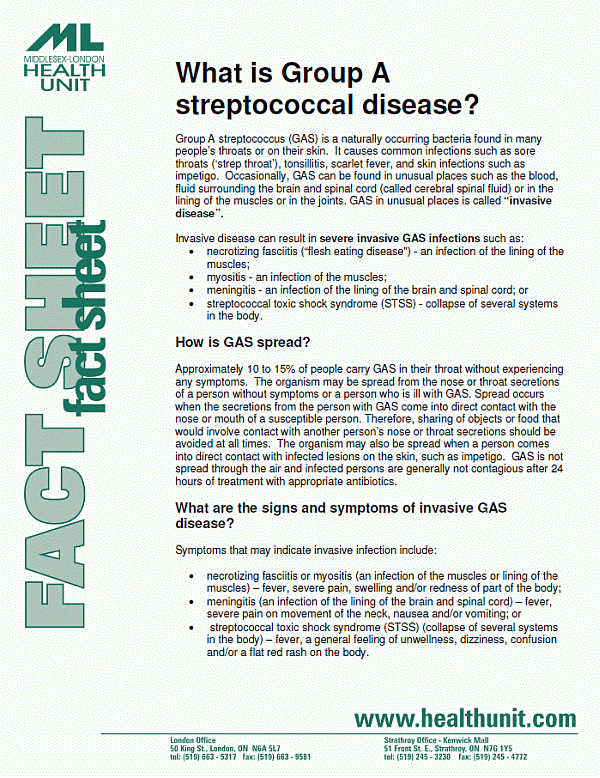How is GAS spread?
GAS bacteria is spread by direct contact with fluids from the nose and throat of an infected person, or by direct contact with discharge/fluids from infected wounds. GAS is not spread through the air. Infected persons are generally not contagious after 24 hours of treatment with the right antibiotics.
Who is at greatest risk of developing invasive Group A strep infection?
Those at highest risk of developing invasive group A strep infection include people who:
- are over the age of 65 years and very young children,
- have weak immune systems, such as those who are immunosuppressive chemotherapy, or have HIV infection,
- have a chronic disease, such as diabetes, heart or lung disease, or cancer,
- use injection drugs,
- abuse alcohol, and
- have chronic skin breaks and sores, including children with chickenpox. (It is recommended children receive 2 doses of chickenpox vaccine.)
How can group A strep infection be prevented?
It is recommended that everyone:
- Wash your hands regularly especially after coughing or sneezing, before handling or eating food, after cleaning or handling a cut or sores;
- Keep all sores clean, and watch for possible signs of infection such as quick increase in redness, swelling, fluid, and pain at the sore site. Seek medical care if infection is not improving as it may spread rapidly;
- Cover your mouth and nose when you cough or sneeze; use a tissue or your sleeve, not your hands;
- Avoid sharing cups/water bottles, utensils and cigarettes;
- Do not share drugs, needles, filters and other drug related items; and
- Stay at home for at least 24 hours after the start of antibiotic treatment for strep throat or impetigo.
Who is a close contact?
Close contacts include the following people:
- Those living in the same household as the sick person and who have spent at least four hours/day with the sick person in the seven days before the person became sick;
- Those who share a bed with the sick person;
- Those who have had direct contact with the sick person through mouth to mouth resuscitation, open mouth kissing, or an open skin lesion;
- Injection drug users who share needles/equipment with the sick person.
Classroom, daycare, workplace, and social contacts generally are not considered close contacts.
Whether given antibiotics or not, anyone who is a close contact with a person positive for invasive group A strep, should watch for symptoms of GAS and should seek immediate medical attention if they begin to feel unwell.
